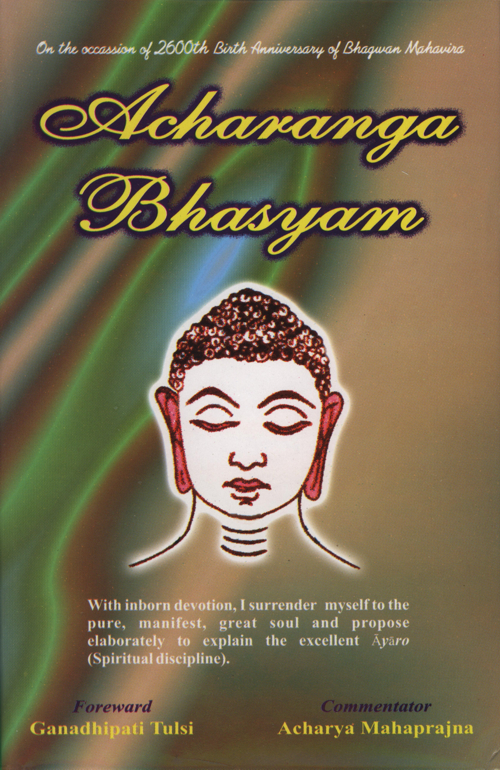5.116 supaḍilehiya awato savvayāe sammameva samabhijjāṇiyā.
Examining all doctrines from all sides and in all respects, one should practice the truth alone.
Bhāṣyaṃ Sūtra 116
One should not transgress the injunction, after having properly investigated the doctrine of the Jina through anyone of the three sources of knowledge, namely, one's own memory of past life and the like. He should follow the injunction, after having properly understood it completely with reference to substance, space, time and modes through external and internal evidence.
5.117 ihārāmaṃ pariṇṇāya, allīṇa-gutto parivvae.
ṇiṭṭhiyaṭṭhī vīre, āgameṇa sadā parakkamejāsi tti bemi..
Comprehending the state of self-absorption and being self-engrossed and self-controlled he should lead the life of a monk. Such successful and heroic monk should always exert himself according to the spiritual commandment—thus do I say.
Bhāṣyaṃ Sutra 117
'He should comprehend the nature of self-absorption. The meaning of the self-absorption is the practice of penance, discipline and self-restraint, renunciation and conquering of hardships and troubles. Knowing such self-absorption through comprehensive knowledge and abandoning the non-absorption through renunciative knowledge, the monk should deeply be engrossed in the self and conquer the senses. Such monk blessed with the accomplishment of the practice of self-discipline and being courageous should always exert himself in accordance with the instructions of scripture' - thus do I say.
5.118 uḍḍhaṃ sotā ahe sotā, tiriyaṃ sotā viyāhiyā.
ete soyā viyakkhāyā, jehiṃ saṃgaṃti pāsahā..
There are streams above, below and from the sides. These have been declared as streams, through which, look, there is affection.
Bhāṣyaṃ Sūtra 118
There are seven secretory centres in upper part of the body, viz., mouth, two ears, two eyes and two nostrils. In the middle of the body, there are two breasts. In the lower part, there are anus, penis and vagina.[1] These are the secretory centres.
The 'secretory centres' means the sense-organs or the parts of the body employed for the enjoyment of the respective sense. In the ninth chapter (9.1.16), twofold secretory centres have been mentioned, that is, the intaking centre and the outgoing centre. Here the intaking centre is meant.[2]
'Look! these secretory centres are responsible for affection, that is, attachment'.[3]
5.119 āvaṭṭaṃ tu uvehāe, ettha viramejja veyavῑ.
Examining the whirlpool, a man, versed in the sacred lore, should keep off from it.
Bhāṣyaṃ Sūtra 119
The whirlpool is to be explained as 3.6. Having examined, that is, closely observing the whirlpool, the learned person should withdraw from the whirlpool.
5.120 viṇaettu soyaṃ ṇikkhamma, esa mahaṃ akammā jāṇati pāsati.
Having abandoned the sensual objects, the renouncer of the world and the great aspirant, knows and perceives the truth, being freed from knowledge-covering and intuition-covering karma.
Bhāṣyaṃ Sūtra 120
Having renounced the world and subjugating the secretory centres, that is, the objects of the senses, viz., sound and the like, the great monk, having restrained attachment and hatred, becomes free from action. In other words, he becomes engrossed in meditation or becomes free from the knowledge-covering karma and is able to know and intuit the secretory centre.[4]
5.121 paḍilehāe ṇāvakaṃkhati, iha āgariṃ gatiṃ pariṇṇāya.
Comprehending by means of investigating the cycle of birth and death that revolves due to attachment to the sensual objects, the self-engrossed person does not hanker after it.
Bhāṣyaṃ Sūtra 121
The sensual objects owing to the ambitions of the person become the causes of his passion of attachment and hatred. In the absence of the ambitions, those objects become merely knowable things. They do not produce any evil disposition. One should comprehend that the worldly coming and going, that is, the cycle of birth and death takes place only in a person overpowered by attachment and hatred. A person renouncing the world with such comprehension does not hanker after those secretory centres, that is, he is not tempted by those currents.[5]
5.122 acceijāi-maraṇassa vaṭṭamaggaṃ vakkhāya-rae.
A monk, engaged in the study of the lore and its meaning, transcends the cyclic path of birth and death.
Bhāṣyaṃ Sūtra 122
'Lore' stands for the scripture[6] both as text and meaning. A monk, engaged in the scripture, crosses the cyclic path of life and death.
(The state of soul which has crossed the cyclic path is now described).
 Acharya Mahaprajna
Acharya Mahaprajna

